
Commelina communis var. communis (Asiatic Dayflower) on 9-8-18, #504-18.
NOTE! I screwed up. This is Commelina communis var. communis NOT Commelina erecta! I am working on this page to correct it… GEEZ!!!
Asiatic Dayflower
Commelina communis
(Commelina communis var. communis)
kom-uh-LIN-uh/kom-uh-LEE-nuh KOM-yoo-nis
Synonyms of Commelina communis var. communis (30) (Updated on 12-13-23 from Plants of the World Online): Commelina barbata Bojer (1837), Commelina communis f. alba Ti Chen (1994), Commelina communis f. albiflora Makino (1910), Commelina communis f. albomaculata Sugim. (1973), Commelina communis f. albomarginata Tuyama (1948), Commelina communis f. alboradiata Tuyama (1948), Commelina communis var. angustifolia Nakai (1909), Commelina communis f. aureostriata Tuyama (1948), Commelina communis f. caeruleopurpurascens Makino (1931), Commelina communis f. candida Hiyama (1953), Commelina communis var. ciliata Masam. (1960)(nom. illeg.), Commelina communis f. ciliata Pennell (1939), Commelina communis f. ciliata (Masam.) Murata (1993)(nom. illeg.), Commelina communis f. diabolica (Koidz.) Sugim. (1973), Commelina communis subsp. exserta Pennell (1938), Commelina communis var. exserta (Pennell) F.G.Bernard (1968), Commelina communis var. hebespatha H.Hara (1938), Commelina communis f. hebespatha (H.Hara) Sugim. (1967), Commelina communis var. hortensis Makino (1901), Commelina communis f. leucantha Nakai (1935), Commelina communis f. minor (Y.N.Lee & Y.C.Oh) M.Kim (2017), Commelina communis f. miranda Hiyama (1953), Commelina coreana H.Lév. (1910), Commelina diabolica Koidz. (1939), Commelina minor Y.N.Lee & Y.C.Oh (1981), Commelina nipponica Koidz. (1939), Commelina polygama Roth (1790), Commelina vulgaris Redouté (1808)(not validly publ.), Commelina willdenowii Kunth (1843), Disecocarpus polygamus (Roth) Hassk. (1870). There were only 14 on the last update on 11-16-21.
Commelina communis L. is the accepted scientific name for the Asiatic Day Flower. It was named and described as such by Carl von Linnaeus in the first edition of Species Plantarum in 1753.
AAccepted infraspecific names (2) (Updated on 12-13-23): Commelina communis var. communis (type specimen), Commelina communis var. ludens (Miq.) C.B.Clarke. When a form, variety (variant), or subspecies is named an autonym (“type specimen”) is automatically named that is closest to the species. This page is for Commelina communis var. communis…
The genus, Commelina Plum. ex L. was described as such by Carl von Linnaeus in the first edition of Species Plantarum in 1753. Mr. Linnaeus noted that the genus had been previously named and described by Charles Plumier.
As of 12-13-23 when this page was last updated, Plants of the World Online lists 201 species in the Commelina genus. It is a member of the plant family Commelinaceae with 36 genera. Those numbers could change as updates are made.
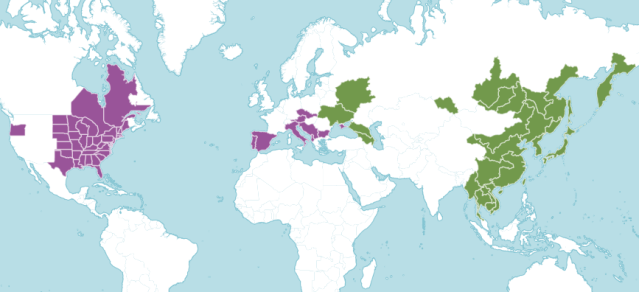
Distribution map of Commelina communis from Plants of the World Online. Facilitated by the Royal Botanic Gardens, Kew. Published on the Internet; http://www.plantsoftheworldonline.org/. Retrieved on January 27, 2020.
The above map from Plants of the World Online shows where Commelina communis is native in green and purple where it has been introduced. The species could be in other areas but may not have been reported. The USDA Plants Database shows a similar map of the United States but also includes the state of Washington.
The map on iNaturalist shows where members have made observations. Anyone can join and it is a great website to confirm and share your observations. The maps on iNaturalist are continually updated as members post new observations.
THERE ARE SEVERAL LINKS AT THE BOTTOM OF THE PAGE FOR FURTHER READING AND TO HELP WITH A BETTER POSITIVE ID.
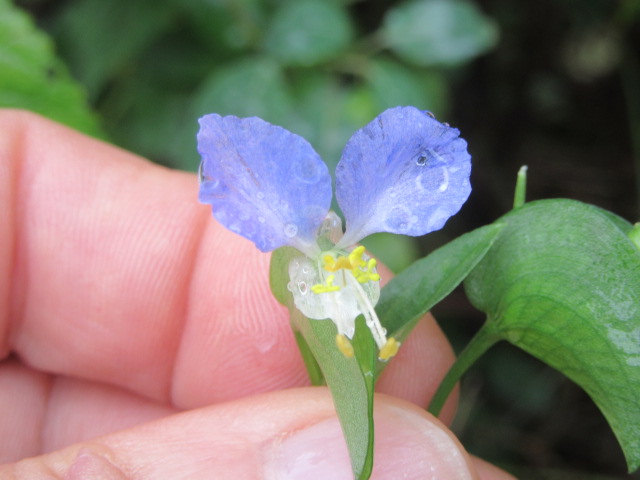
Commelina communis var. communis (Asiatic Dayflower) on 9-8-18, #504-19.
2019 was a great year for identifying wildflowers on the farm. I took photos of Dayflowers in 2018 but I was just barely getting started identifying the wildflowers here. In 2019, I decided to ID as many as I could but I got fairly busy at a friend’s farm.
I remember these plants with blue flowers when I was a kid growing along the house where I grew up. I pretty much forgot about them until I moved back to the family farm and started taking an interest in wildflower ID. I had several flower beds and tried to keep them weed-free, but once I became more interested in wildflowers, I was more selective and let several species grow. Several I just let grow where they wanted, while others weren’t so appreciated. Then in 2018, I ran across the blue flowers growing somewhere, possibly in a wooded area north of the pond behind the barn. At the time, I hadn’t heard of iNaturalist and was looking at flower photos on the Missouri Plants website. What I found that was similar was Commelina erecta because of the light blue flowers. Being a newbie at the time, without reading the descriptions carefully and knowing plant parts like I do now, that name stuck. Even though after I knew the plant parts and realized the C. erecta on the farm didn’t match the “keys”, I was still hellbent the plants producing the “lighter blue” flowers with NO maroon spots on the false anthers were C. erecta. I uploaded photos and observations on iNaturalist as C. erecta even though there was evidence to the contrary. I just thought the plants in the two large colonies of C. erecta were somewhat whacky with their open spathelike bracts rather than being fused like they were supposed to be. It wasn’t until 2023, 4 years after posting the observations, that an iNaturalist member disagreed and suggested C. communis. Now, I had already posted observations for C. communis with the maroon dots on their false anthers… So, I disagreed with his disagreement. He flagged an expert on Commelina, who joined the discussion… After several days and even sending messages back and forth, I was convinced of my error… I had previously taken notes from Steyermark’s Flora of Missouri, which is what the Missouri Plants website also uses. I went back and read my notes… Then I had to correct what I had written and even upload corrected photos… GEEZ!
Here’s my story…

Commelina communis var. communis (Asiatic Dayflower) on 8-29-19, #617-1.
In 2019, I found a very large colony along a ditch north of the pond where the pasture drains that lead to the pond. At first, I was checking their flowers sterile anthers for maroon dots which is a characteristic of C. communis. The flowers had no maroon bots which led me to think this colony was Commelina erecta. There was a strange problem… The spathlike bracts the flowers emerge from on Commelina erecta are supposed to be fused from the elbow to the base while the bracts of C. communis are supposed to be open (like a taco). However, all the flowers in this colony were open instead of fused… The flowers had light blue petals whereas C. communis, I thought, had darker flowers … So why were their bracts open instead of fused?
The above photo shows where flowers emerge from spathelike bracts at the top of the stems.
One of the big problems doing research about Commelina communis is that many websites only have photos and descriptions of flowers with maroon spots on the false (sterile) anthers. However, the original plants named were without these maroon spots. Many websites were not written by botanists and perhaps the authors didn’t do thorough research. I did the research but was confused for 4 years… Descriptions online that are written by botanists, or people in that area, about this species “without” the maroon spots may mention Commelina communis var. ludens that have the spots. Many websites use the name Commelina communis and say the maroon spots are a key feature. How are they a key feature if they aren’t as widespread as those without?
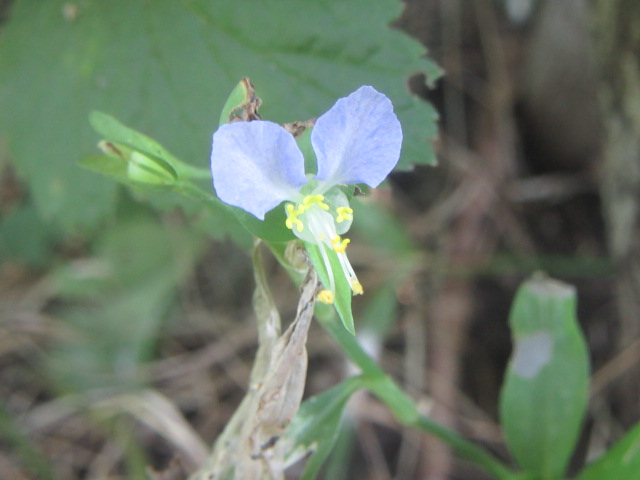
Commelina communis var. communis (Asiatic Dayflower) on 8-29-19, #617-2.
Commelina communis is an introduced species, which means they are not a native wildflower in North America. While plants with flowers that have maroon spots are the predominant variety in some areas, as a whole, Commelina communis var. communis (the type specimen) without the spots are the dominant variety in the entire eastern half of North America. There are very few maps that separate C. communis var. communis and C. communis var. ludens (the variety with the maroon spots). Those that do, show a very limited range for the latter even in their native lands. Here on the farm, even though I found the two very large colonies of C. communis var. communis in 2019, I haven’t noticed any since. Maybe because I was looking at the wrong time… C. communis var. ludens continue to grow around the borders of the yard and in the north flower bed…

Commelina communis var. communis (Asiatic Dayflower) on 8-29-19, #617-3.
The spathe-like bracts of C. communis are smoothly rounded whereas C. erecta bracts have an “elbow” and are NOT smoothly rounded… Plus they are fused together from the elbow to the base while C. communis var. communis are not fused. The bracts appear to be folded so what looks like the lower part is actually the midrib. If you have identified similar characteristics to flowers you have identified as C. erecta, think again…

Commelina communis var. communis (Asiatic Dayflower) on 8-29-19, #617-4.
NICE! Flowers open in succession, but many bracts have two flowers that are open at the same time. Flowers supposedly only last for one day.

Commelina communis var. communis (Asiatic Dayflower) on 8-29-19, #617-5.
Flowers of Commelina communis var. communis have two upper light blue petals and a smaller lower white petal. The shade of blue varies… Flowers have three false anthers and three fertile anthers. The petals are a lighter blue than C. communis var. ludens and they have no reddish-brown spots.

Commelina communis var. communis (Asiatic Dayflower) on 8-29-19, #617-6.
I take a lot of photos and sometimes I have no words for them…

Commelina communis var. communis (Asiatic Dayflower) on 8-29-19, #617-7.
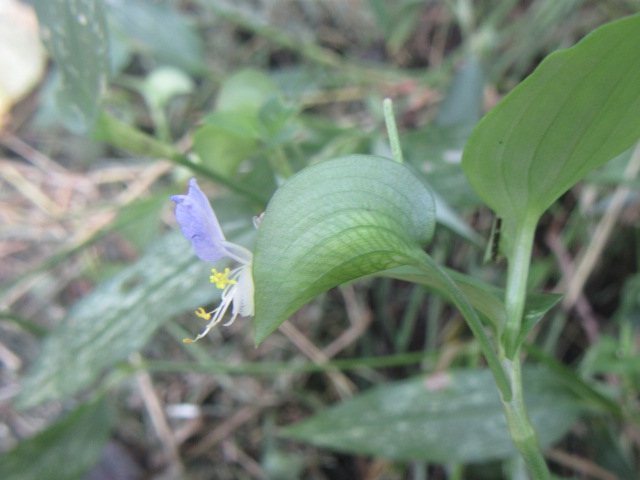
Commelina communis var. communis (Asiatic Dayflower) on 8-29-19, #617-8.
Here you see perhaps a clearer photo of a spath-like bract with a smooth curve. It’s somewhat hard to tell, but between the veins, you can see less prominent alternate veins that seem to connect the more pronounced horizontal veins. These smaller veins are supposedly not as noticeable on C. erecta.

Commelina communis var. communis (Asiatic Dayflower) on 8-29-19, #617-9.
The ovaries of the flowers turn into seed-bearing fruit. In my opinion, the bract appears to be fused where it isn’t torn, but farther down it appears not to be fused… Some of the bracts aren’t so easy to open like the one in the above photo…

Commelina communis var. communis (Asiatic Dayflower) on 8-29-19, #617-10.
Leaves are lanceolate to slightly ovate and have a sheath that surrounds the stems. The sheaths have small white hairs. Leaves grow in an alternate pattern on the stems. Another distinguishing feature between C. communis and E erecta is that the base of the leaves of C. erecta has spreading auricles of tissue. That is not found on C. communis. You can view this on the Missouri Plants website by clicking HERE.

Commelina communis var. communis (Asiatic Dayflower) on 8-29-19, #617-11.
Above is a better photo of the leaf sheaths… I like my camera, but I need a better one so I can close-ups without using a magnifying glass in front of the lens…

Commelina communis var. communis (Asiatic Dayflower) on 8-29-19, #617-12.
Although a little blurry, in the above photo you can see the spathlike bract is free to the base.

Commelina communis var. ludens on the left and C. communis var. communis on the right on 9-1-19, #620-10.
Finally, on September 1 as I was leaving the area, I looked down on the left side of where I went in and spotted a few plants with darker blue flowers. I took a closer look and low and behold the sterile anthers had reddish-brown spots. I had found Commelina communis! But, something was weird! Their bracts were fused together where they should have been open! I thought maybe I had them backwards even though I was sure I knew what I was looking for. After I took several photos, I went back inside to check. Sure enough, Commelina communis are supposed to have open bracts. That is one of the feature characteristics that separate it from C. erecta, besides having reddish-brown spots. Well, that was what I originally wrote when I thought the flower on the right was C. erecta. The flower on the left is C. communis, but so is the flower on the right… Commelina communis var. ludens and Commelina communis var. communis… You can also see the difference in color between the two as well as the size of the petals.

Commelina communis var. ludens on the left and C. communis var. communis on the right on 9-1-19, #620-11.
The above photo clearly shows something I originally thought was very screwey. How can C. erecta (on the right) have open bracts when they are supposed to be fused, and how can C. communis (on the left) have fused bracts when they are supposed to be open? That is because what I thought was C. erecta is C. communis var. communis and the other is C. communis var. ludens. with closed bracts. Closed but not fused…

Commelina communis var. communis (Asiatic Dayflower) on 9-1-19, #920-20.
Most information says Commelina erecta is considered a perennial while C. communis is an annual.
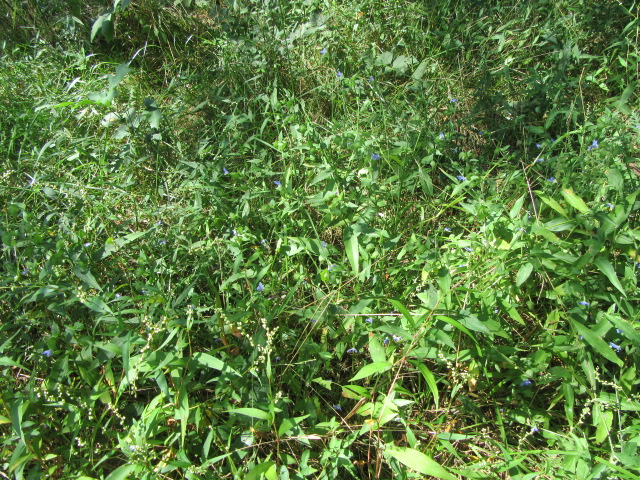
Colony of Commelina communis var. communis (Asiatic Dayflower) by the pond at the back of the farm on 9-7-19, #625-2.
The above photo is of a large colony of Commelina communis var. communis I found in front of the pond in the back pasture. Commelina commmunis, like other species in the genus, have erect to ascending stems. That means they grow upright until they get long enough to sprawl. Stems on the ground root at the nodes.

Commelina communis var. communis (Asiatic Dayflower) by the back pond on 9-7-19, #625-3.
I took a lot of photos of the flowers and bracts because they are the most interesting part of the plant.

Commelina communis var. communis (Asiatic Dayflower) by the back pond on 9-7-19, #625-4.
The above shows where I easily opened the bract. If this had been C. erecta, I would have had to tear it open or at least have a very sharp knife. The Missouri Plants page shows a similar photo of C. erecta. Perhaps when a second flower emerges or the fruit get bigger, the bract opens. I am not sure, since apparently, I haven’t seen a C. erecta in person…
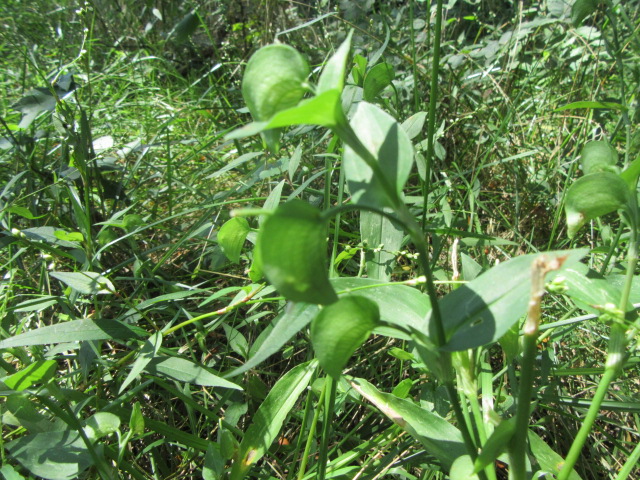
Commelina communis var. communis (Asiatic Dayflower) by the back pond on 9-7-19, #625-7.
The above is a good photo showing several bracts, all smoothly curved…

Commelina communis var. communis (Asiatic Dayflower) by the back pond on 9-7-19, #625-8.
The above photo shows two flowers at the same time. Most of what I saw was one flower at a time…

Commelina communis var. communis (Asiatic Dayflower) by the back pond on 9-7-19, #625-9.
When I took the above photo, I thought I had finally found a C. erecta with a fused bract. Now I know it is a C. communis with a closed bract…

Commelina communis var. communis (Asiatic Dayflower) by the swamp with a closed bract on 9-7-19, #625-10.
I walked farther down toward the end of the southeast pasture and found a flower with closed bracts (not fused). As you can see, the end of the spathe-like bract is open… C. erecta would be fused to the base.
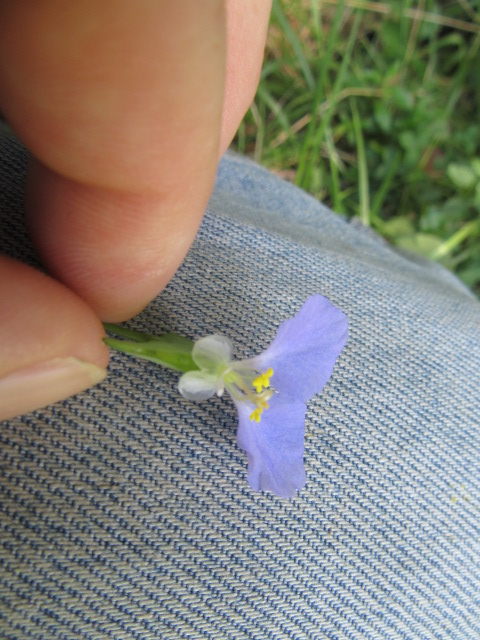
Commelina communis var. communis (Asiatic Dayflower) on 9-7-19, #625-11.
I haven’t noticed any Commelina communis var. communis on the farm since 2019. That seems a bit odd since there were two HUGE colonies… You just never know.
I also have pages for Commelina diffusa (Spreading Dayflower) and Commelina communis var. ludens (Asiatic Dayflower) if you are interested.
I keep looking for more Commelina communis var. communis, but as of 2023, I haven’t found any. Hopefully, I will run across more in 2024.
I have enjoyed photographing and learning about the many wildflowers growing on the farm and in other areas. I have grown over 500 different plants and identified over 250 species of wildflowers (most have pages listed on the right side of the blog). I am not an expert, botanist, or horticulturalist. I just like growing, photographing, and writing about my experience. I rely on several websites for ID and a horticulturalist I contact if I cannot figure them out. Wildflowers can be somewhat variable from location to location, so sometimes it gets a bit confusing. If you see I have made an error, please let me know so I can correct what I have written.
I hope you found this page useful and be sure to check the links below for more information. They were written by experts and provide much more information. If you can, I would appreciate it if you would click on the “Like” below and leave a comment. It helps us bloggers stay motivated. You can also send an email to me at thebelmontrooster@yahoo.com. I would enjoy hearing from you.
FOR FURTHER READING:
PLANTS OF THE WORLD ONLINE (GENUS/SPECIES/VAR.)
INTERNATIONAL PLANT NAMES INDEX (GENUS/SPECIES)
TROPICOS (GENUS/SPECIES)
FLORA OF MISSOURI (GENUS/SPECIES)
FLORA OF NORTH AMERICA (GENUS/SPECIES)
WORLD FLORA ONLINE (GENUS/SPECIES)
WIKIPEDIA (GENUS/SPECIES)
DAVE’S GARDEN
MISSOURI PLANTS
MSU-MIDWEST WEEDS AND WILDFLOWERS
iNATURALIST
WILDFLOWER SEARCH
USDA PLANTS DATABASE
ILLINOIS WILDFLOWERS
MINNESOTA WILDFLOWERS
NORTH CAROLINA STATE UNIVERSITY
IOWA PLANTS
GO BOTANY
KANSAS WILDFLOWERS AND GRASSES
PFAF (PLANTS FOR A FUTURE)
NOTE: The data (figures, maps, accepted names, etc.) may not match on these websites. It depends on when and how they make updates and when their sources make updates. Some websites have hundreds and even many thousands of species to keep up with. Accepted scientific names change periodically and it can be hard to keep with as well. Some of the links may use a name that is a synonym on other sites. In my opinion, Plants of the World Online by Kew is one of the most reliable and up-to-date plant databases and they make updates regularly. I make updates “at least” once a year and when I write new pages or add new photos but I do get behind. We are all a work in progress. 🙂
These pictures are all of Commelina communis. Note the contrasting veins on the spathes and the lack of auricles at the leaf bases.
LikeLike
Hello Daniel! Great to hear from you! In 2019, where I took a lot of the photos of both species, you can tell the difference between the two in several ways. Look at photo #620-10… Commelina communis on the left is a darker blue and has distinctive maroon spots on the anthers. That may not always be the case, because Steyermark’s Flora of Missouri mentions a (former) C. communis var. communis without the spots. Like I mentioned, the colony of C. communis were on one side of the area and C. erecta were on the other. The auricles were not something I considered at the time. I was unable to find either species in 2020 where I saw them in 2019 which is weird since the colonies of C. erecta were fairly large. There are several C. communis here and there along the edge of the yard and in a couple of flower beds this year that weren’t there before. I will check a couple of places again for the C. erecta and see if I can check out the auricles mre closely. Take care and thanks for the comment and suggestion.
LikeLike